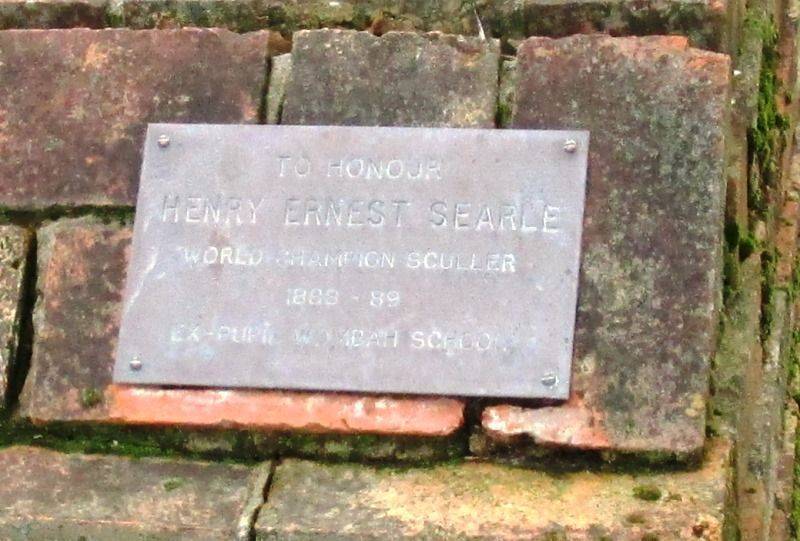
www.monumentaustralia.org.au
Henry Ernest SearlePrint Page 

15-May-2014
Photographs supplied by John Huth
The plaque commemorates Henry Ernest Searle, who was the the world champion sculler from 1888 to 1889. Henry Searle was a former pupil of the Wombah School.
Henry Searle (1886–1889), a sculler known as the ‘Clarence River Comet’, took up rowing as a boy as a means of getting himself and his siblings to and from school. Aged 22, having had some success competing in skiffs at local regattas, Searle went to Sydney for professional training, and between June and October 1888 won a number of races on the Parramatta and Hunter Rivers, some of which, at three miles, were the same distance he had rowed each way to school as a boy. In a race on the Parramatta River on 27 October 1888, he beat compatriot and reigning world champion, Peter Kemp, by 150 yards, netting himself both the world title and a winner’s purse of £1000. According to one report, upwards of 30,000 spectators watched the race from boats and vantage points along the course, and later crowded the city’s ‘principal sporting hostelries’ to discuss the impressiveness of Searle’s win and person. He confirmed his standing as the ‘King of Scullers’ with a convincing victory over Canadian William O’Connor in a race on the Thames in October 1889.
Though then at the peak of his much-commented-upon fitness, Searle contracted typhoid on the voyage home and died, aged 23, on 10 December 1889, three weeks after his ship berthed in Melbourne. At a period when rowing was on par with cricket and boxing in terms of mass popularity, Searle’s untimely passing was met with great displays of public grief. Thousands gathered at railways stations to see the train that transported his body back to Sydney, where, it is said, 170,000 people turned out for his memorial service. Searle was buried in the cemetery at Maclean on the Clarence River; a monument to him was later erected on the Parramatta River on the rocks that had marked the finishing line in his famous 1888 victory.
View Google Map
Henry Searle (1886–1889), a sculler known as the ‘Clarence River Comet’, took up rowing as a boy as a means of getting himself and his siblings to and from school. Aged 22, having had some success competing in skiffs at local regattas, Searle went to Sydney for professional training, and between June and October 1888 won a number of races on the Parramatta and Hunter Rivers, some of which, at three miles, were the same distance he had rowed each way to school as a boy. In a race on the Parramatta River on 27 October 1888, he beat compatriot and reigning world champion, Peter Kemp, by 150 yards, netting himself both the world title and a winner’s purse of £1000. According to one report, upwards of 30,000 spectators watched the race from boats and vantage points along the course, and later crowded the city’s ‘principal sporting hostelries’ to discuss the impressiveness of Searle’s win and person. He confirmed his standing as the ‘King of Scullers’ with a convincing victory over Canadian William O’Connor in a race on the Thames in October 1889.
Though then at the peak of his much-commented-upon fitness, Searle contracted typhoid on the voyage home and died, aged 23, on 10 December 1889, three weeks after his ship berthed in Melbourne. At a period when rowing was on par with cricket and boxing in terms of mass popularity, Searle’s untimely passing was met with great displays of public grief. Thousands gathered at railways stations to see the train that transported his body back to Sydney, where, it is said, 170,000 people turned out for his memorial service. Searle was buried in the cemetery at Maclean on the Clarence River; a monument to him was later erected on the Parramatta River on the rocks that had marked the finishing line in his famous 1888 victory.
Location
| Address: | Iluka Road, Recreation Reserve, Woombah, 2469 |
|---|---|
| State: | NSW |
| Area: | AUS |
| GPS Coordinates: | Lat: -29.359692 Long: 153.282043 Note: GPS Coordinates are approximate. |
Details
| Monument Type: | Plaque |
|---|---|
| Monument Theme: | People |
| Sub-Theme: | Sport |
| Link: | http://adb.anu.edu.au/ |
Dedication
Front Inscription
Source: MA, ADBTo honour Henry Ernest Searle
World Champion Sculler
1888 – 89
Ex-pupil Wombah School
Monument details supplied by Monument Australia - www.monumentaustralia.org.au



